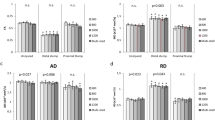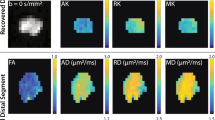Abstract
Objective
Diffusion kurtosis imaging (DKI) has been proven to provide additional value for assessing many central nervous system diseases compared with conventional diffusion tensor imaging (DTI); however, whether it has the same value in peripheral nerve injury is unclear. This study aimed to investigate the performance of DKI, DTI, and electromyography (EMG) in evaluating peripheral nerve crush injury (PNCI) in rabbits.
Materials and methods
A total of 27 New Zealand white rabbits were selected to establish a PNCI model. Longitudinal DTI, DKI, and EMG were evaluated before surgery and 1 day, 3 days, 1 week, 2 weeks, 4 weeks, 6 weeks, and 8 weeks after surgery. At each time point, two rabbits were randomly selected for pathological examination.
Results
The results showed that fractional anisotropy (FA) derived from both DKI and DTI demonstrated a significant difference between injured and control nerves at all time points (all P < 0.005) mean kurtosis of the injured nerve was lower than that on the control side after 2–8 weeks (all P < 0.05). No statistically significant difference was found in radial kurtosis, axial kurtosis, and apparent diffusion coefficient at almost every time point. The difference in compound muscle action potential (CMAP) of the bilateral gastrocnemius at each time point was statistically significant (all P < 0.001).
Conclusions
CMAP was a sensitive and reliable method to assess acute PNCI without being affected by perineural edema. DKI may not be superior to DTI in evaluating peripheral nerves, DTI with a shorter scanning time was preferred as an effective choice for evaluating acute peripheral nerve traumatic injury.








Similar content being viewed by others
References
Sunderland S (1951) A classification of peripheral nerve injuries producing loss of function. Brain 74(4):491–516
Chhabra A, Madhuranthakam AJ, Andreisek G (2018) Magnetic resonance neurography: current perspectives and literature review. Eur Radiol 28(2):698–707
Li X, Chen J, Hong G, Sun C, Wu X, Peng MJ, Zeng G (2013) In vivo DTI longitudinal measurements of acute sciatic nerve traction injury and the association with pathological and functional changes. Eur J Radiol 82(11):e707-714
Yamasaki T, Fujiwara H, Oda R, Mikami Y, Ikeda T, Nagae M, Shirai T, Morisaki S, Ikoma K, Masugi-Tokita M, Yamada K, Kawata M, Kubo T (2015) In vivo evaluation of rabbit sciatic nerve regeneration with diffusion tensor imaging (DTI): correlations with histology and behavior. Magn Reson Imaging 33(1):95–101
Jensen JH, Helpern JA (2010) MRI quantification of non-Gaussian water diffusion by kurtosis analysis. NMR Biomed 23(7):698–710
Spampinato MV, Chan C, Jensen JH, Helpern JA, Bonilha L, Kautz SA, Nietert PJ, Feng W (2017) Diffusional kurtosis imaging and motor outcome in acute ischemic stroke. Am J Neuroradiol 38(7):1328–1334
Yuan L, Sun M, Chen Y, Long M, Zhao X, Yin J, Yan X, Ji D, Ni H (2016) Non-Gaussian diffusion alterations on diffusion kurtosis imaging in patients with early Alzheimer’s disease. Neurosci Lett 616:11–18
Lehmann HC, Zhang J, Mori S, Sheikh KA (2010) Diffusion tensor imaging to assess axonal regeneration in peripheral nerves. Exp Neurol 223(1):238–244
Manzanera Esteve IV, Farinas AF, Pollins AC, Nussenbaum ME, Cardwell NL, Kang H, Does MD, Thayer WP, Dortch RD (2019) Probabilistic assessment of nerve regeneration with diffusion MRI in rat models of peripheral nerve trauma. Sci Rep 9(1):19686
Wan Q, Wang S, Zhou J, Zou Q, Deng Y, Wang S, Zheng X, Li X (2016) Evaluation of radiation-induced peripheral nerve injury in rabbits with MR neurography using diffusion tensor imaging and T2 measurements: correlation with histological and functional changes. J Magn Reson Imaging 43(6):1492–1499
Sun C, Hou Z, Hong G, Wan Q, Li X (2014) In vivo evaluation of sciatic nerve crush injury using diffusion tensor imaging: correlation with nerve function and histology. J Comput Assist Tomogr 38(5):790–796
Morisaki S, Kawai Y, Umeda M, Nishi M, Oda R, Fujiwara H, Yamada K, Higuchi T, Tanaka C, Kawata M, Kubo T (2011) In vivo assessment of peripheral nerve regeneration by diffusion tensor imaging. J Magn Reson Imaging 33(3):535–542
Yang M, Yan Y, Wang H (2018) IMAge/enGINE: a freely available software for rapid computation of high-dimensional quantification. Quant Imaging Med Surg 9:210
Andersson G, Oradd G, Sultan F, Novikov LN (2018) In vivo diffusion tensor imaging, diffusion kurtosis imaging, and tractography of a sciatic nerve injury model in rat at 9.4T. Sci Rep 8(1):12911
Takagi T, Nakamura M, Yamada M, Hikishima K, Momoshima S, Fujiyoshi K, Shibata S, Okano HJ, Toyama Y, Okano H (2009) Visualization of peripheral nerve degeneration and regeneration: monitoring with diffusion tensor tractography. Neuroimage 44(3):884–892
Chen YY, Zhang X, Lin XF, Zhang F, Duan XH, Zheng CS, Chen MW, Wang DY, Zeng WK, Shen J (2017) DTI metrics can be used as biomarkers to determine the therapeutic effect of stem cells in acute peripheral nerve injury. J Magn Reson Imaging JMRI 45(3):855–862
Boyer RB, Kelm ND, Riley DC, Sexton KW, Pollins AC, Shack RB, Dortch RD, Nanney LB, Does MD, Thayer WP (2015) 4.7-T diffusion tensor imaging of acute traumatic peripheral nerve injury. Neurosurg Focus 39(3):E9
Takemura MY, Hori M, Yokoyama K, Hamasaki N, Suzuki M, Kamagata K, Kamiya K, Suzuki Y, Kyogoku S, Masutani Y, Hattori N, Aoki S (2017) Alterations of the optic pathway between unilateral and bilateral optic nerve damage in multiple sclerosis as revealed by the combined use of advanced diffusion kurtosis imaging and visual evoked potentials. Magn Reson Imaging 39:24–30
Kelm ND, West KL, Carson RP, Gochberg DF, Ess KC, Does MD (2016) Evaluation of diffusion kurtosis imaging in ex vivo hypomyelinated mouse brains. Neuroimage 124(Pt A):612–626
Zhu J, Zhuo C, Qin W, Wang D, Ma X, Zhou Y, Yu C (2015) Performances of diffusion kurtosis imaging and diffusion tensor imaging in detecting white matter abnormality in schizophrenia. NeuroImage Clin 7:170–176
Glenn GR, Tabesh A, Jensen JH (2015) A simple noise correction scheme for diffusional kurtosis imaging. Magn Reson Imaging 33(1):124–133
Rosenkrantz AB, Padhani AR, Chenevert TL, Koh DM, De Keyzer F, Taouli B, Le Bihan D (2015) Body diffusion kurtosis imaging: basic principles, applications, and considerations for clinical practice. J Magn Reson Imaging 42(5):1190–1202
Funding
This work was supported by the National Natural Science Foundation of China (Grant Number: 81171800.) and Science and technology planning project of Guangdong Province (Grant Number: 2016A020215168.)
Author information
Authors and Affiliations
Contributions
The study was conceived and designed by QW and XL; material preparation and data collection were performed by YY, YB, JH, PW, YP, and XX; data analysis and interpretation were performed by YY, QW, YL, and JL; the first draft of the manuscript was written by QW and all authors commented on previous versions of the manuscript. All authors read and approved the final manuscript.
Corresponding author
Ethics declarations
Conflict of interest
The authors have no conflicts of interest to declare.
Ethical approval
All animals were used in accordance with the procedures of the Health Guide for the Care and Use of Laboratory Animals and approved by the Institutional Animal Use and Care Committee.
Additional information
Publisher's Note
Springer Nature remains neutral with regard to jurisdictional claims in published maps and institutional affiliations.
Supplementary Information
Below is the link to the electronic supplementary material.
Rights and permissions
About this article
Cite this article
Wan, Q., Yu, Y., Bao, Y. et al. Evaluation of peripheral nerve acute crush injury in rabbits: comparison among diffusion kurtosis imaging, diffusion tensor imaging and electromyography. Magn Reson Mater Phy 35, 291–299 (2022). https://doi.org/10.1007/s10334-021-00952-x
Received:
Revised:
Accepted:
Published:
Issue Date:
DOI: https://doi.org/10.1007/s10334-021-00952-x




